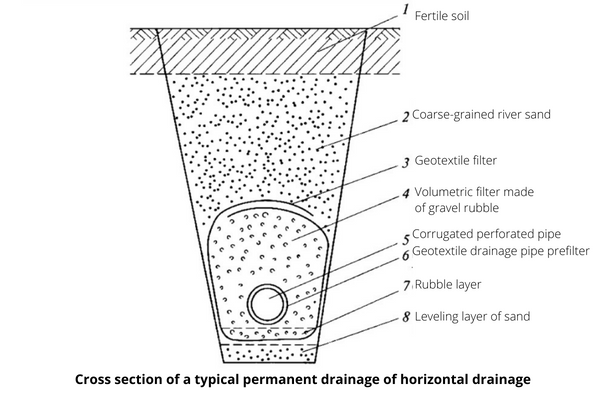Table of Contents
- How to check the operation of the drainage and the quality of its installation?
- Construction expertise in drainage and its full examination
The drainage system is designed to drain water from a building, house, or plot. Drainage of discharge of water from the building —is an auxiliary element, thanks to which the installed waterproofing system will last 5 times longer since it will not be constantly under the pressure of water and aggressive environment.
If there are violations of technology during the installation of the drainage system, then it simply will not work or will work at 10-30% of its capacity. Fixing the situation will cost twice as much as doing everything right initially.
In order to fix an improperly made drainage, you will have to:
- Dig out the drainage pipe;
- To change improperly performing drainage slopes or poor-quality drainage pipes;
- Mount everything anew according to the design standards.
How to check the operation of the drainage and the quality of its installation?
In order for the drainage system to work correctly and fulfill its purpose at 100%, it should be installed according to all design standards and technologies.
The most common mistakes of builders when installing drainage:
- Non-compliance with slopes or performing counter-slopes;
- Incorrect selection of drainage installation marks. For example, drainage around the building should be installed below the foundation slab and not flush with it, so that it takes the maximum amount of water from under the building, thereby protecting a weak cold seam (slab-wall);
- Filling the drainage with materials with a low water filtration coefficient, for example, soil or quarry dirty sand;
- Lack of inspection wells for maintenance of drainage systems;
- An improperly performed drainage– is a looped system that brings only harm instead of benefit.
How to understand that your drainage is not working properly?
- There is water in your basement (relevant if we are talking about deep drainage around a building or a private house;
- In case of wet soil and precipitation, the water in the collector or its collection point (the lowest point) does not come out of the drainage pipes;
- There is no collector or tank where drainage water should drain (this indicates a looped system);
- There are no inspection wells at the main corners and turns;
- The drainage is covered with soil or clay.
You can read more about the drainage system arrangement in the article – “Turnkey drainage arrangement around the house: Proper drainage, its types, installation technologies, materials, schemes, and prices“.

Construction expertise in drainage and its full examination
For the examination and inspection of the drainage system, you need to call an engineer who will carry out the following activities:
- Visual examination
- Checking the slopes
- Checking the correctness of the drainage installation work
- Quality control of the materials used (crushed stone, sand, perforated pipe in geotextile, etc…)
Drainage inspection and testing is always carried out by an expert in the design and examination of drainage and discharge systems. To conduct the survey, it may be necessary to perform drilling and sampling of soil and sand cores for laboratory studies.
Based on the results of the drainage examination, an official conclusion will be given to you, recommendations for correction (if there are shortcomings), and a detailed estimate for all necessary repair and restoration measures.

Stages of the construction expertise of drainage:
- Study of project documentation – In case there is one;
- Visual inspection – a visual inspection of all surface elements associated with the drainage system, such as a collector or a water collection tank, inspection wells, a discharge channel, and pumping equipment, is carried out;
- Checking the slopes of the drainage performed – is possible to do in the presence of inspection wells. A measuring installation is lowered into these wells, with the help of which the slopes of the existing drainage pipe are installed.
- Testing the capacity of drainage pipes – Performed by the method of pouring drainage with water or using a special camera for video inspection of the system;
- Performing pits in several places of the system occurrence– With the help of this event, the expert opens the entire layers of the drainage prism and looks at its component;
- Examination of the materials used in the drainage arrangement – checking the quality of the materials used, for example, the quality of sand used for filling;
- In-house processing of all received data;
- Providing a detailed conclusion with recommendations for correction.









